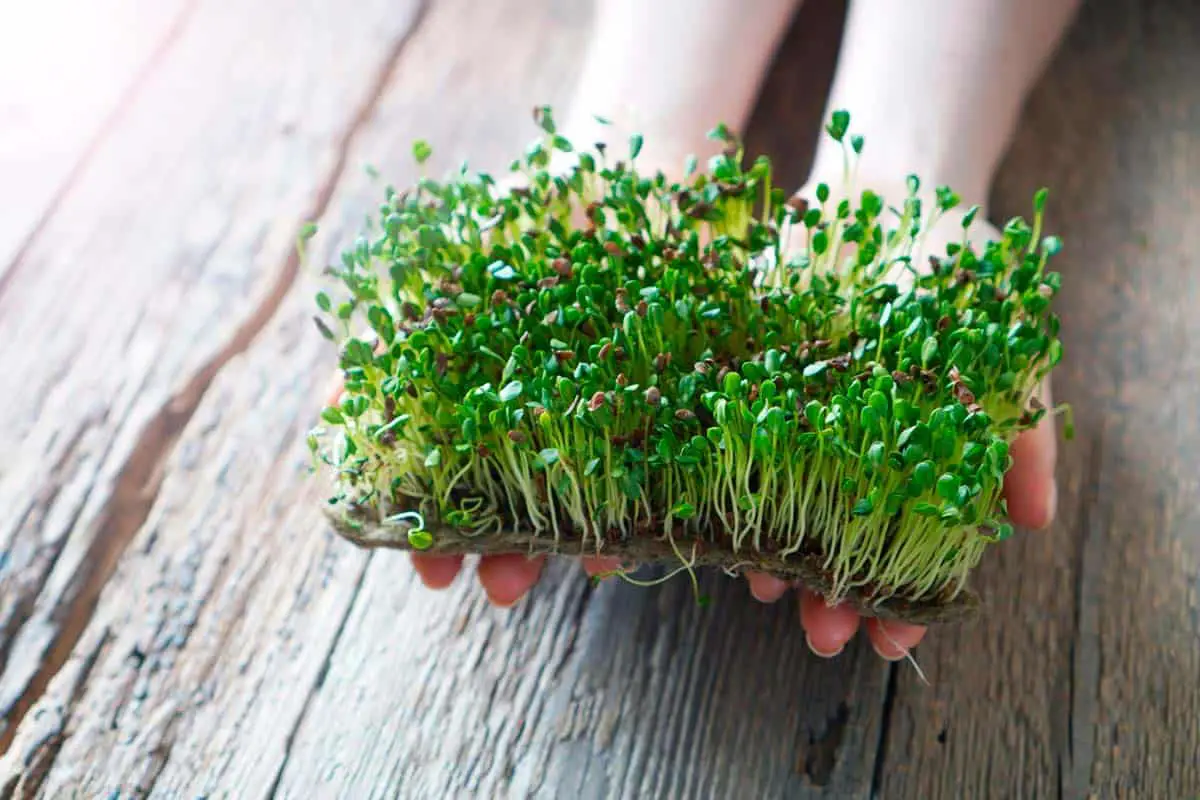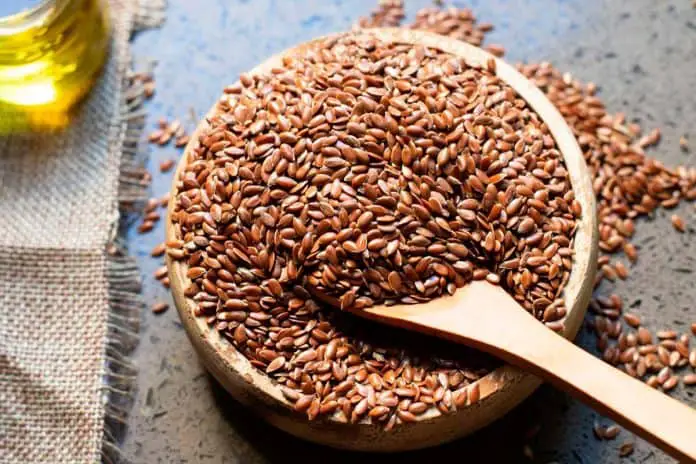Can you grow microgreens from flax seeds? Flax seeds have gained popularity as a health food, and more people have found the benefits of this seed and use it for smoothies, as oats, or for baking. But did you know that you can grow healthy microgreens from flax seeds?
Typically, most microgreens are grown using conventional seeds such as sunflowers, watercress, and broccoli. But there are so many more interesting seeds to grow from, and the Flax seed is one of them. Are flax seeds able to produce delicious, healthy, and viable microgreens?
Yes, you can grow microgreens from flax seeds. Flax microgreens are the source of various healthy nutritional components, and as small greens, they are not only jam-packed with nutrition, but they also hold a nutty, smooth taste that is perfect for many meals.
What is Flax, the health benefits of the said microgreen, and how can I grow them? This article will discuss “can you grow microgreens from flax seeds” and these additional topics.
What Is Flax?
Before discussing flax seeds’ viability as a microgreen, let us explore what Flax is. Flax is a flowering plant known as linseed, and most of the time, many farmers cultivate it as a fiber crop in temperate regions, as opposed to a food option. As for food, only a few consume flax mature. Instead, flax is a great option to consume along with your cereal as a seed (typically grounded).
Flax Come In Various Forms
- Linseed oil
- Ground flax seeds
- Cloth fibers
- Linen
- Bed sheets
- Industrial Paint
- Microgreens
Flax has a lot of purposes aside from being a great microgreen. Due to flax’s versatility, you have most likely used one or more products deriving from it. For example, in Western countries, textiles made from flax are known as linen and are traditionally used for bed sheets, underclothes, etc.
Moreover, you can use oil from flax and extract it as linseed oil. Flax flowers can be of different colors. Common variants of flower colors include light blue, white, yellow, and red.
Which Type Of Flax Seed Should You Use As A Microgreen?
Flax seeds come in two fundamental colors/varieties: brown and yellow (golden linseeds), which you can utilize to cultivate microgreens. Yellow flax seeds, in particular, contain a high Omega-3 fatty acid content. When selecting a flax seed type for use as a microgreen, you can pick either type.
What Are The Health Benefits Of Flax Microgreens?

Aside from being a versatile and edible product, flax seeds can be incredibly nutritious. When you eat them as microgreens, most of the nutritional benefits listed below are condensed into smaller factors and healthier than other forms. Below, we list the health benefits of flax microgreens.
- High in nutritional content
- Flax is high in fiber
- Rich in omega-3 fatty acids
- Can lower blood pressure
- Can lower cholesterol
High In Nutritional Content
Flax is great for a variety of reasons. One reason is that it contains many nutrients compressed in such a small form factor. Below, using an official document from the USDA, we list a few of the nutritious content flax microgreens have.
Nutritional Content of Flax Microgreens
- Flax microgreens contain a lot of b-vitamins such as Thiamine (B1), Riboflavin (B2), Niacin (B3), Pantothenic acid (B5), Vitamin B6, and Folate (B9).
- Aside from b-vitamins, flax microgreens also have ascorbic or vitamin C.
- Flax microgreens have a lot of minerals. For example, it has Calcium, Iron, Magnesium, Phosphorus, Potassium, and Zinc.
- Flax microgreens carry a lot of good oils and fats. Monounsaturated fats in flax can help reduce bad cholesterol. Flax also has polyunsaturated fats that help reduce heart diseases. These can manifest in the forms of omega-3 and omega-6.
High In Fiber
Fiber is an essential component that aids in digestion. What’s impressive is that consuming even a bit of flax will fulfill a significant portion of your daily fiber requirement.
Flax is one of the few plants with both soluble and insoluble fiber. Stool bulk is increased by soluble fiber. Furthermore, it absorbs water in your intestines and delays digestion, which may aid blood sugar regulation and cholesterol reduction.
On the other hand, insoluble fiber improves digestion and reduces constipation by accelerating food through the digestive tract. It may also help to avoid constipation and maintain regular bowel motions. (source)
Rich In Omega-3 Acids
As said earlier, flax microgreens contain many healthy fatty acids, such as omega-3 and omega-6. These fatty acids may sound ominous because they have “fat” and “acid” in the name, but they are incredibly beneficial to your health.
Read more about flax microgreens.
What To Use When Growing Flax Microgreens (Materials)
Now that we have learned what Flax is and how healthy it is, let us get into how we can transform those seeds into small edible plants!
Can you grow microgreens from flax seeds? Yes, you certainly can, and in this section of the article, we will discuss how to grow them on your own. Growing flax microgreens is not too different from growing other microgreen types. If you are already well-versed in developing other varieties of microgreens, you might find the steps below quite familiar.
Before we start growing flax microgreens, we must first prepare the materials and utensils that will help us develop these microgreens. For comfort, below we list the required materials for growing flax microgreens:
- Tray or another container to plant your seeds and a cover tray
- Growing medium (organic potting soil, coconut coir, or another soilless growing medium
- Water spray bottle
- Flax seeds
- Scissors or sharp knife (for harvest)
How To Grow Flax Microgreens (The process)
When you have collected all of the above you are ready to get started. The overall growing period for Flax microgreens is about ten days. We break it down into these different phases:
- Germination period (blackout) – Day 1-4
- Growth time (sunlight)- Day 5-7
- Harvest- Day 8-12
1) Planting your seeds
To plant your seeds you start by filling up a tray (or another container such as a to-go salad bowl). We use 10/20 trays (one bottom tray and one top tray with holes) designed for growing microgreens as they make the process more convenient and will ease when it is time for harvesting.
Fill up your tray with the growing medium of your choice, about 1–2 inches (2.5–5.1 centimeters). You can use an organic potting mix, coconut coir, or another soilless growing medium. Our preference is coconut coir because it is eco-friendly, bacteria-free, and odorless. Perfect for growing microgreens at home!
Lightly compress the growing medium with your hands and then spread about 1 oz of seeds evenly across the tray. Give the seeds a good mist of water, and then place a tray cover to initiate the next part of the growing process.
Note that Flax seeds are mucilaginous (similar to Chia seeds), which means that when they get wet, they create a jelly substance around the seed.
2) Blackout period
Once your seeds are covered, leave them so they are not exposed to any light for about four days. This is called the blackout period, and it is done to emulate the seed’s growing process below ground.
During these days, lift the cover twice per day, and give the seeds a mist with your water bottle. You want the soil to be moist but not soaked. After around four days, you will see that seeds start to germinate, and yellowish stems will start to grow.
3) Bring them out in the light
Once the seeds have germinated, it is time to remove the cover and bring them out in the light. Continue to water your flax microgreens twice a day, to ensure they do not dry out, nor should they get oversoaked. If you are using a bottom tray, you can water from below instead of on top of the microgreens.
Learn more about how to water your microgreens.
During the growth period, your microgreens need light. Put your tray near a well-lit window, and give them at least 6-8 hours of light. If you can’t get this from natural light, you can set up grow lights. For best growth results, microgreens should get around 12-15 hours of light a day and around 9-12 hours of darkness.
4) Harvesting
Once the flax microgreens have reached about an inch, it is time for harvesting! This is the exciting part! You can use a sharp knife or scissors to cut your microgreens. Lift them and cut just above soil level. You want to avoid getting the growing medium with your freshly cut microgreens. Once you have harvested your microgreens, place them in an airtight container and put them in the refrigerator. They will stay fresh for a couple of days. Unless you are ready to eat them directly!
Summary
Can you grow flax microgreens? Yes, you can, and these healthy seeds are ideal for it. Do you have flax seeds and want to try a new way of enjoying these healthy seeds, then grow them as microgreens! Within 8-12 days you have cultivated yourselves a superfood that you can enjoy in almost any meal.
Not only are flax microgreens easy and quick to grow, but they truly are a great source of nutrition. Use them to garnish your favorite food, or eat them raw, your choice!


